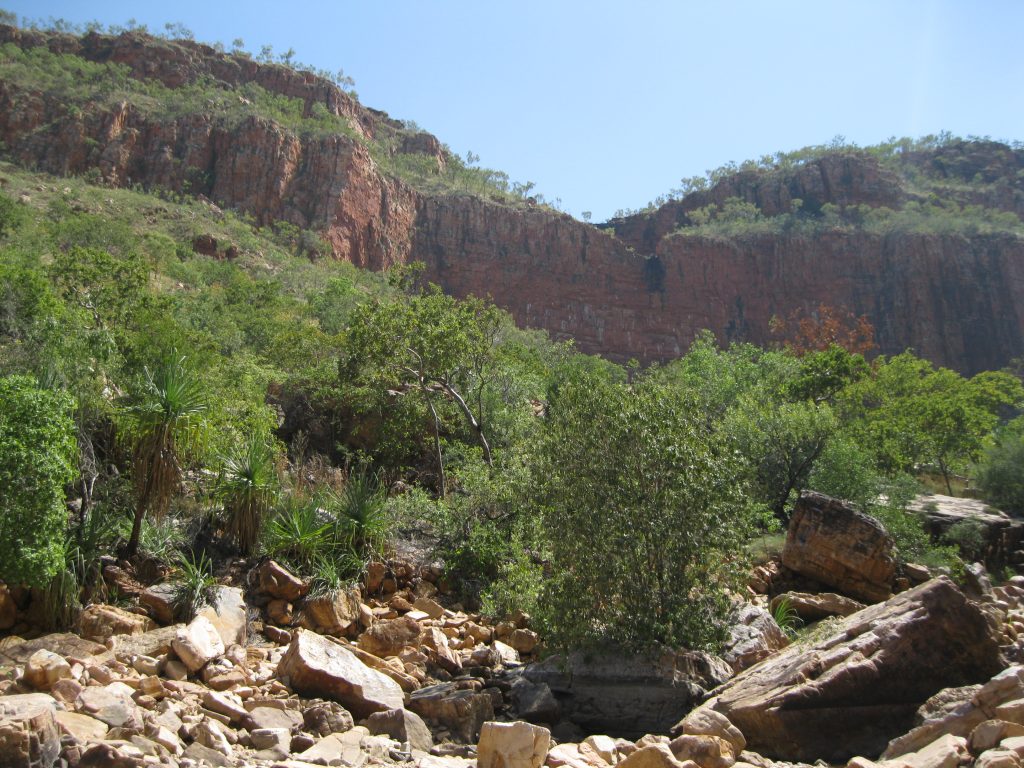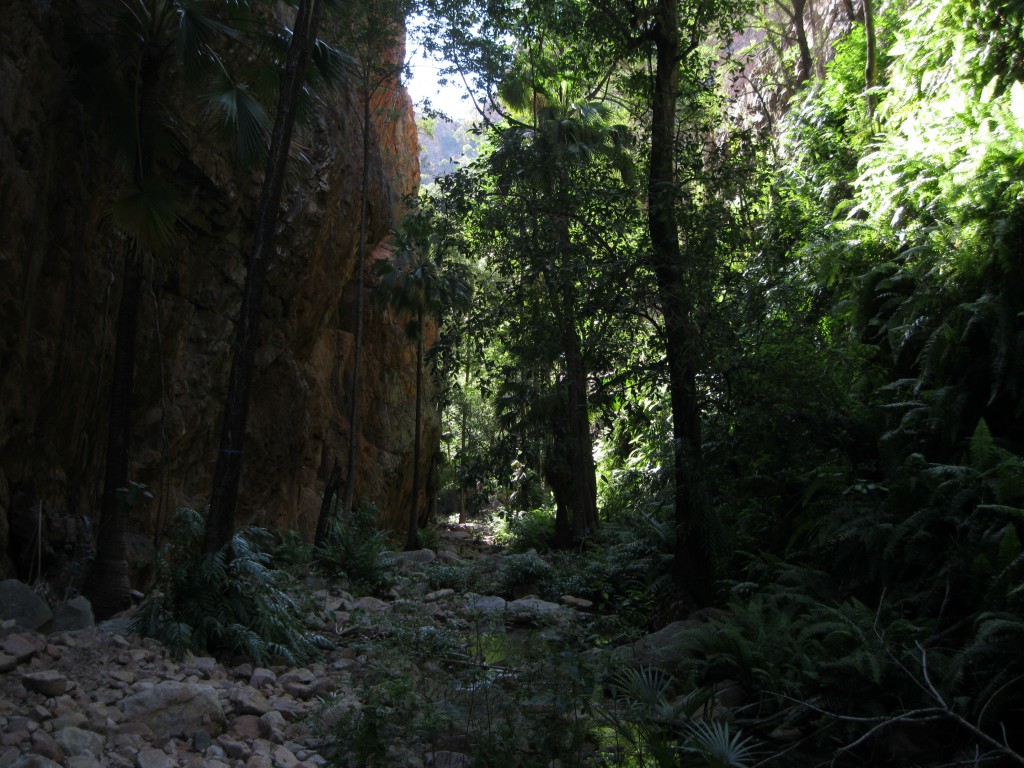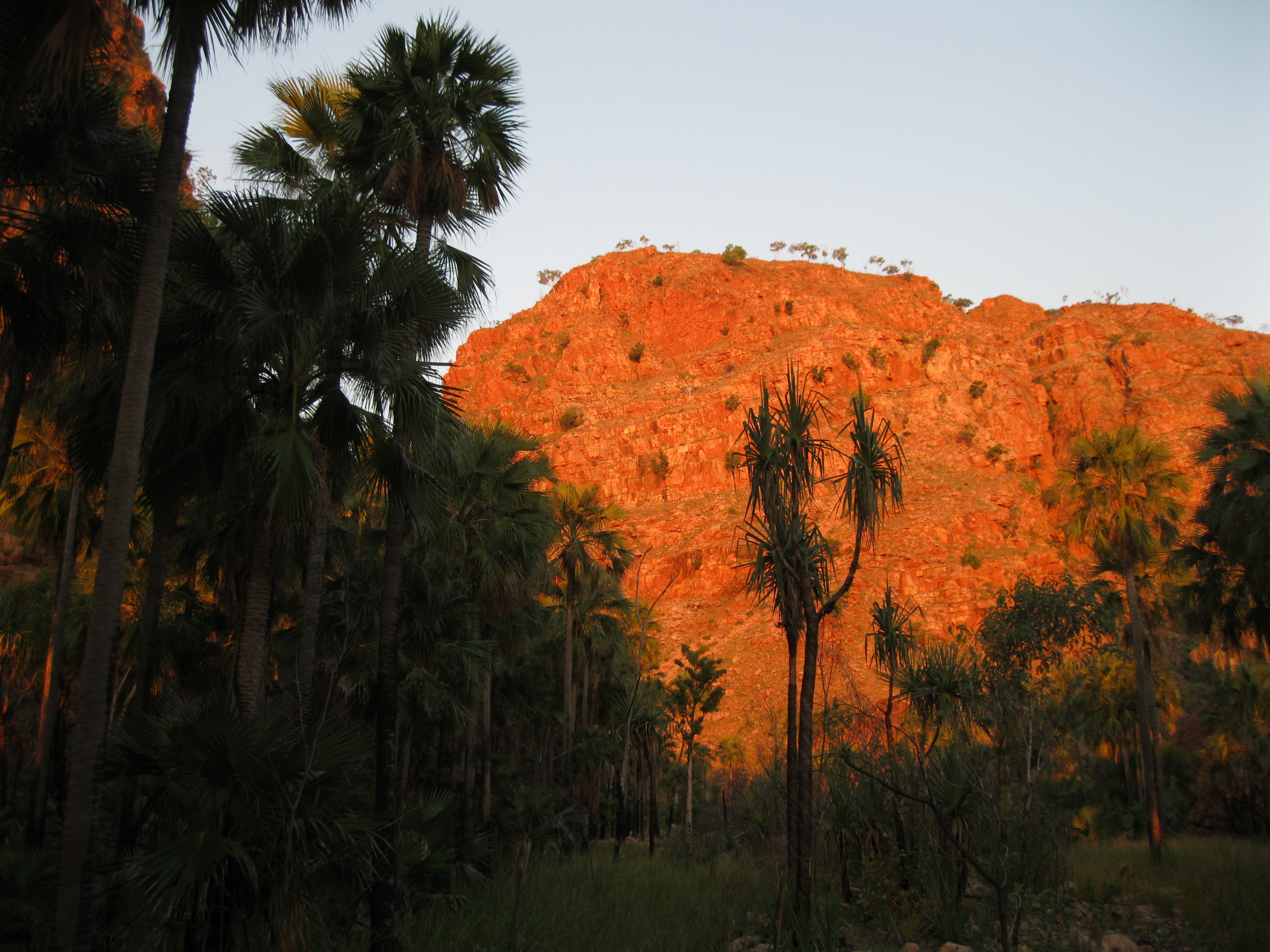Spectacular Rugged Scenery
El Questro Wilderness Park is the authentic Outback experience and the perfect getaway for the adventurer. You will be stunned by its beauty
The Park is a privately owned and is located in the Kimberly region in the northern part of Western Australia about 110 km (69 miles) west of Kununurra. The property is 4,047 square km (1,563 square miles) in size and is accessible from the Gibb River Road. To visit and stay in the park you need a permit which can be obtained at the Station Store, Emma Gorge or at the reservations office in Kununurra. If you are travelling with an organised tour this will have been sorted for you. The area is absolutely amazing and there are plenty of opportunities to go hiking and explore the Outback.

It’s located on the Kimberley plateau and consists of relatively flat high country with some sandstone escarpments stretching more than ten kilometres (6.25 miles). This includes some pretty amazing scenery of the Cockburn Ranges along the Gibb River Road. A rugged landscape of tablelands and mesas rise up to 800 metres (2,625 ft) in the central part of the plateau and dip north and west towards the sea. The escarpments are up to 300 metres tall (984 ft) with steep walls in gorges carved through by rivers.
Geology: The Formation of the Amazing Landscape
Between 1,790 and 1,835 million years ago the rocks that today form the Kimberley Plateau were deposited in the Kimberley Basin and large overlapping rivers. Thick beds of sandstone are interlayered with beds of pebble and boulder conglomerate, mudstone, shale, dolomite and basalt. Sedimentary rocks followed by volcanic rocks were intruded by dolerite, formed by molten rock being injected between layers of sandstone to form thick sills

The Kimberley Plateau is about 250 million years old. It was uplifted and eroded around 100 to 200 million years ago and again 50 to million years ago. Rivers cut through the sandstone about 20 million years ago, creating the beautiful gorges of the area. Cross-bedding is visible in some of the rocks with steeply dipping layers which document the passage of sand dunes in the river beds and across the sea floor. The shape of the cross-beds show the direction in which the rivers and sea currents were flowing.
History: The Property
Present day El Questro Wilderness Park used to be a cattle station formerly known as Spurling’s Pocket but was not a success due to the rugged landscape. The ownership changed several times and in 1958 Torrance MacMiking and Morris Marshall acquired the place and renamed it El Questro.
In 1991 the property changed hands yet again to Will and Celia Burrel who would find the place worn down with trees fallen down on the roads and buildings being in a bad state. But they saw potential in the property. The same year they started developing it into a wilderness park and the following year Emma Gorge’s Resort was built and the park opened in May 1992.

Today El Questro Wilderness Park is owned by Delaware North Parks and Resorts which acquired the property in 2010. Even though a big part of the operation is tourism it is still also a working cattle station with about 6,000 head of heard.
One of the mysteries of El Questro is where the name comes from. It is quite unusual and strange to have a Spanish place name in the middle of the Australian Outback. The answer is simple. Nobody knows where the name comes from which just adds a bit of additional mystique to the place.
The Facilities
There are several different options for accommodation such as luxury suites, bungalows, tented cabins and the facilities at the campsite at El Questro Station are really nice. Some of the best you will find in the Kimberley Outback. There are plenty of opportunities to get a good shower and also to get your washing done if that is necessary.

The station has a neat restaurant and bar as well. After a full day of hiking and exploring it’s nice to head down to the bar and have a chill, a beer and a chat with fellow travellers. Next to the bar you will find a cool seating area where you can also set up a campfire. Some of the locals may also stop by and hang out and you will get to hear about life in the remote Outback.
At Emma Gorge, safari cabins are available for accommodation and at the Homestead, luxury rooms and suites are an option if you want to spoil yourself.
Zebedee Springs
El Questro Wilderness Park is perfect if you are up for a bit of adventurous hiking or even just for a more relaxed walk. If you are up for the latter, Zebedee Springs, which are permanent thermal pools, is a great option. High pressure and heat for the earth’s interior keeps the temperature to around 32 degrees Celsius all year (89.6 degrees Fahrenheit). It’s a short easy walk from the car park to the pools of a 1.5 km (0.94 miles) return trip which will take you about 30 minutes if you do not enter the pools.

If you enter the pools remember to be aware of the slippery rocks. Note that there is no access to the trail after 12 o’clock noon. It is highly recommended that you do go for a dip as it is absolutely beautiful and such a nice refreshing experience. There are several pools at Zebedee Springs fed by beautiful cascades, surrounded by a vast vegetation of stunning livistona palms. Lie back, chill and look up at the canopy of the palm trees. Amazing sight. You can shift between them as you like. It may also depend on how crowded it is when you visit.
The surrounding cliffs and scree slopes are around 1,800 million years old and consist of King Leopold Sandstone. The boulders found are the result of two surfaces grinding against each other for thousands of years. The broken down material then formed conglomerate.
The Plant & Bird Life of Zebedee Springs
Along the trail you will see livistona palms, named after the Baron of Livingstone, swamp bloodwood which is a eucalyptus tree and wild mango in the savannah scree slopes. You may also see a little frairbird, sulphur-crested cockatoo, blue-winged kookaburra or a brown honeyeater flying about among the trees. The specific species of the livistona palm tree locate here, is only found at Zebedee Springs and at Purnululu National Park. This tree can grow up to 18 metres (59 ft) and form a thick canopy which provides shade and a cooler temperature.

The age can roughly be determined by counting the rings around the trunk divided by four. You will also find some savannah woodland forest with northern woolybutt, ironwoods, northern kurrajong and swamp bloodwoods. The vegetation in the lower part include ribbon grass, hopbush, Kimberley horse poison and “walkabout weed”. You may also find a peaceful dove, rufous whistler, weebill or northern fantail flying around.
Emma Gorge
If you are up for a good hike, some beautiful scenery and a dip you should check out Emma Gorge. Prior to walking the gorge you have to report at the reception located at the gorge. Emma Gorge is a part of the Cockburn Ranges and is one of the most significant attractions of El Questro Wilderness Park. The rocks surrounding the gorge are sandstone and shale of the Bastion group which date back 1,800 million years.

The trees predominant on the valley floor are the swamp bloodwoods and the pandanus palms, furthermore some banjan trees and sticky kurrajongs can be seen. Animals you may encounter could be the double barred finch, great bowerbird or black footed rock wallaby. You will see a lot of cane toads in this area which in an introduced species that have become a huge a pest to the environment around Outback Australia.
The trail is a 3.2 km (2 miles) return walk and is split into different points. Along the way you will find blue diamond shaped numbers with the ELQ logo indicating these points. Note that between the points there are blue markers which will point out the route of the trail. Wearing hiking boots would be a good idea and bring at least a litre of water. Bear in mind that is not possible to access to the gorge after 15:00 hours.

Initially the trail is easy as you make your way through grassland and a forest section. You will be passing a beautiful creek surrounded by massive towering rock walls of sandstone. The rock walls will become more impressive as the gorge narrows in. The terrain gets more challenging and rocky and you will have to use your navigation skills more as you head on. It is not too strenuous though. On your way you will notice rocks with ripples which were created when sediments were deposited under shallow tidal water.
Towards the final part of the hike you will enter a section where the vegetation changes drastically to from savannah woodland to rainforest. This will provide shade and make it cooler. The following section will have more boulders which you will have to negotiate through until you get to the First Pool which is an alternative swimming area to the main pool at the end of the hike only 200 metres (656 ft) away.

When you arrive at the end of the trail Emma Pool will appear with the beautiful 65 metre (213 ft) tall Emma Gorge Waterfall as the backdrop where you can have a dip. It will be quite cold but also very refreshing, so definitely make your way into the pool, swim all the way over to the rock wall and experience the waterfall dripping down on you. Just amazing in this beautiful gorge. So awesome. Take your time and enjoy it. Return to the shore and have a chill on the pebble beach of the gorge. So relaxing. It just doesn’t get any better.
You will be returning via the same trail so you will get to see the gorge for the opposite direction which is cool. When you get down to the reception area of Emma Gorge you will find a café as well where you can have a well-deserved relax and a cup of coffee after your hike. This is a very nice and cosy spot.
El Questro Gorge
If you are interested in a real scenic adventure, you should do a hike in El Questro Gorge. The trail has 16 points and is divided into two sections. The short walk, being the first section (Blue Trail), is just as challenging as Emma Gorge. The long walk, being the second portion of the trail (Red Trail), is more challenge and pretty strenuous. At the trailhead you can pick up a trail map at the visitor information sign that shows the different points on the trail. If you are doing the whole trail you should bring 2-3 litres of water, a hat, sunscreen and a pair of sturdy hiking boots.

The whole hike is a 6.8 km (4.25 miles) return trip and will take about 4-5 hours without a swim. The climate in the gorge is pretty humid due to lush rainforest and the gorge being deep and narrow. The trail has signage which will help you through to the attractions and back. As in Emma Gorge, follow the blue diamond shaped markers with the ELQ logo and number in the middle and the blue markers and ribbons on the way between the main points. Past the half way point the trail is no longer marked.
The trail begins with a rainforest section with livistona palm trees and the further you walk along it gets into more of a shady section. After a while the trail becomes more elevated, rockier and the vegetation gets thicker. You will turn left, cross the creek and make your way across some loose rocks. As you continue you will turn right and cross the creek again and get to a pool.

At this point the trail will lead you to the right along massive cliff walls with a vast vegetation of bracken ferns to the left of the trail. This section will have more shade due to the towering rock walls and the creek will still be flowing with water but it is fairly shallow. There will be plenty rock figs hugging the cliffs which is a cool sight.
At point 10 the Blue Trail terminates. This is where you will find the Halfway Pool which is a good spot for a break and if you don’t want to continue it’s a great place for a swim as well. You can also have a chill on one of the boulders. To get to the Halfway Pool and back is a 2.6 km (1.6 miles) return trip and without a swim it will take about 2 hours.
Beyond this point, the very challenging part of the hike commences. You should only do the second part, the Red Trail, if you are fit and have some hiking experience. This part of the hike should not be done after 13:00 hours. It is highly recommended doing the Red Trail especially if you’re an adventurous person.

To get to the Red Trail, you have to cross the Halfway Pool, and climb up a rock wall. It really depends on the water level but you will definitely get wet, so bringing some sandals or thongs for this portion would be a good idea. You can do it barefooted as well. As the climb can be a bit of a challenge you may have to help each other out.
This is really cool and definitely worth doing if you are up for it as you will be met by some beautiful scenery. Great fun. Just be aware that you have to be careful as there will be large rocks, steep sections and creeks to cross. Some of the rocks can be a bit slippery and loose and there will be some challenging climbs as well. Especially after you have passed a swimming hole after the Halfway Pool you will get to 130 metre (427 ft) section a bit further down of large boulder which is very rugged and slippery. The more you meander your way forward the more narrow the trail gets. Keep your eyes open as you may just spot some Aboriginal art work as well.

When you get down towards the end of this stretch you have to climb a very narrow and steep section at some small falls. It may be helpful to assist each other as it can be difficult. As you continue onwards you will get to a creek and gorge junction where it is very important that you turn to the left, as you are not allowed to turn right, and head down further slightly left parallel the narrow ledge to Mac Micking Gorge. The trail terminates at the pool where you can have a dip and a bit of a chill.
The small gorge and pool has the backdrop of a small beautiful waterfall. The perfect culmination to a long a challenging hike. Swim down to the end of the pool and to a small ledge just below the waterfall. Have a sit down on the ledge and feel the waterfall dripping down on you. So awesome and refreshing. Get one of your mates to take a photo of you from the other side of the pool.
Have a short breather after your dip at Mac Micking Gorge and take it all in. Then it’s time to return via the same trail as you arrived on. It’s an awesome return hike as you will see the whole gorge from the opposite perspective. When you are back at the rainforest section in the beginning of the trail you may just get some excellent views of the rock walls lit up by the sunset which gives them a magnificent orange red colour.

As opposed to the surrounding woodlands, El Questro Gorge has a bit of a special eco system due to the deep and narrow gorge being flanked by sheer cliffs. The compact rainforest canopy limits the amount of light but it does allow for lush tropical vegetation with beautiful pools. Some of the flora includes the aforementioned livistona palms, rocks figs and spiral pandanus. The fauna is pheasant coucals, pied butcherbirds and mertens water monitors. The cliffs and scree slopes composed of King Leopold sandstone which are also 1,800 million years old. The gorge was carved out and eroded by a creek watercourse followed by a geological block fault line of weakness.
